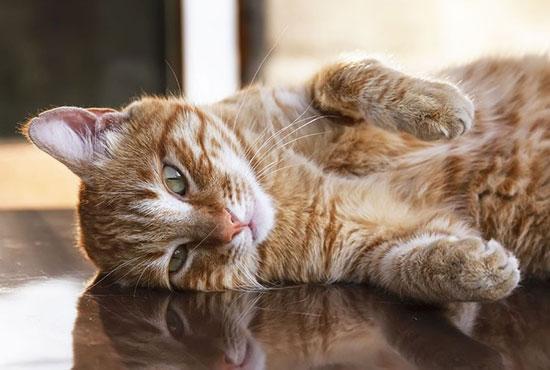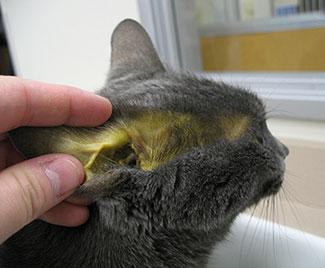This content is archived from the Feline Nutrition Foundation
Avoiding Hepatic Lipidosis in Your Cat
- Updated: Wednesday, May 01, 2019 05:15 PM
- Published: Saturday, November 19, 2011 02:46 PM
- Written by Guillermo Díaz. MV
 I'm transitioning my reluctant kitties to raw cat food and a few times they have refused to eat it. I always end up giving them something else since I have read all of the warnings about going without food for too long and getting hepatic lipidosis.
I'm transitioning my reluctant kitties to raw cat food and a few times they have refused to eat it. I always end up giving them something else since I have read all of the warnings about going without food for too long and getting hepatic lipidosis.
How dangerous is it for them to go without eating? What should I look out for?
Hepatic lipidosis, also called fatty liver disease, may be the most common disease of the liver of the cat. It occurs when there is an excessive accumulation of fat inside the cells and tissues of the liver. If not stopped, this disease will progress and lead to liver and biliary tract dysfunction, and eventual death. But how does it begin?
When a cat has gone for a long period without eating, fat cells stored in the body are metabolized for energy. This is the normal response to starvation in all animals. Fat is packaged with protein and sent through the bloodstream to the cells in the body. But, in an animal that is not eating, there is a lack of available protein to do this, so fat builds up in the liver and disrupts liver function. The resulting liver dysfunction also makes it less likely to want to eat, as it feels sick, thus worsening the situation even more.
There are two types of hepatic lipidosis:
- Idiopathic HL: The cat stops eating, apparently for no reason. This is caused mainly by stress, such as a change of diet, moving, a new animal in the household or the death of a companion animal or human. Cats are very sensitive to changes in their environment.
- Secondary HL: This occurs as a result of a preexisting disease or body condition such as diabetes, gastrointestinal disease, pancreatitis or cholangiohepatitis. All of these can lead to anorexia, which in turn can lead to HL.
How long does a cat have to go without food to be vulnerable to HL?
It depends on the body condition. For example, an obese cat will succumb much sooner to HL than a young, skinny cat. The average range of days without food for this disease to become fatal may vary from two to ten days. If it survives, it's very likely to have organ damage as a result.
Be aware, though, that not all obese cats that go without food will develop HL, and not all who get HL are obese. When there is a suspicion of HL, the veterinarian will measure the liver enzymes, which would be increased if it has the disease. Radiographs and ultrasound imaging may also be used, especially to rule out other diseases associated with secondary HL.¹ But, the only way to be certain about an HL diagnosis is by performing a liver biopsy. This procedure is performed under anesthesia, and the patient must stay overnight at the hospital for monitoring in order to avoid any further complications.
What should I look for?
 Cats with idiopathic HL usually have a history of anorexia and weight loss just prior to being diagnosed. They are also more likely to be obese before the starvation began. The medical history may also include vomiting, diarrhea, constipation, inappetence and lethargy if there is an underlying condition. In later stages of the disease, the cat may have yellowish color mucosa or skin along with an enlarged liver.
Cats with idiopathic HL usually have a history of anorexia and weight loss just prior to being diagnosed. They are also more likely to be obese before the starvation began. The medical history may also include vomiting, diarrhea, constipation, inappetence and lethargy if there is an underlying condition. In later stages of the disease, the cat may have yellowish color mucosa or skin along with an enlarged liver.
How it is treated?
Intensive nutritional therapy is the rule when HL is diagnosed. The cat must get protein and calories for the liver to resume its function and clear out the accumulated fat. Many will need to be fed via a feeding tube, as it likely will not want to eat on its own. This allows it to be given a calorie-dense, high-protein food directly into the stomach or esophagus. This type of feeding will usually be required for several weeks. Electrolytes and vitamins may also be given, based on the individual cat's needs.² If treated in time, most cases can be reversed. Untreated, hepatic lipidosis will lead to death.
Additional Reading
Tips for Transitioning Your Finicky Kitties
How can I prevent hepatic lipidosis in my cat?
Nature knows what is good for your kitty, so in order to prevent the onset of this disease, you have to mimic the frequency and the kind of food it would eat in the wild. This means it shouldn't go more than 24 hours without food. If it still will not eat after 24 hours, it would be a good idea to take it to the vet immediately for a complete checkup.
- Try to provide your cat a stress-free environment.
- Never put your cat on a diet without close veterinary supervision.
- Make sure your cat eats every day.
- Try to prevent obesity. A fat cat is not a healthy cat.
Note: Feline Nutrition provides feline health and nutrition information as a public service. Diagnosis and treatment of specific conditions should always be in consultation with your own veterinarian. Feline Nutrition disclaims all warranties and liability related to the veterinary advice and information provided on this site.
Dr. Guillermo Díaz and family, including their four dogs (Leroy, Xica, Moza and Pepa) and six cats (Michalina, Tigger, Vladimir, Yellow, Mongo and Chirusa) moved to Buenos Aires, Argentina in July of 2017, where he expects to continue supporting different animal rescue groups, spread the benefits of raw food for cats and dogs and write articles about nutrition.
1. Brenda Griffin, DVM, MS, "Feline Hepatic Lipidosis: Pathophysiology, Clinical Signs, and Diagnosis," Compendium on Continuing Education for the Practicing Veterinarian 22, no. 9, September 2000.
2. Sharon A. Center, DVM, "Feline Hepatic Lipidosis," Veterinary Clinics of North America: Small Animal Practice35, 225-268, 2005.




